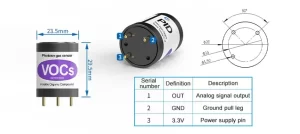Gas sensors, with their ability to detect and measure various gases in the atmosphere, play a crucial role in environmental monitoring. They have witnessed significant advancements in recent years, enabling more accurate and comprehensive data collection. This article explores the progress made in gas sensor technology and its impact on environmental monitoring.

Importance of Environmental Monitoring:
Environmental monitoring is essential for assessing air quality, detecting pollutants, and mitigating potential risks to human health and ecosystems. Gas sensors act as the eyes and ears of this monitoring process by providing real-time data on the presence and concentration of gases in the environment.
Advancements in Gas Sensor Technology:
a. Increased Sensitivity: Modern gas sensors exhibit higher sensitivity, allowing for the detection of even trace amounts of gases. This enhances the accuracy of environmental monitoring and enables early detection of pollutants.
b. Selectivity and Specificity: Newer gas sensors can differentiate between different gases, ensuring reliable and precise measurements. They can identify specific gases of interest while eliminating interference from other substances.
c. Miniaturization and Portability: Gas sensors have become smaller, more portable, and easier to integrate into various monitoring devices. This advancement has facilitated the widespread deployment of sensors for continuous monitoring in diverse environments.
Applications of Gas Sensors in Environmental Monitoring:
a. Air Quality Monitoring: Gas sensors are vital in measuring pollutant levels such as nitrogen dioxide (NO2), ozone (O3), carbon monoxide (CO), and volatile organic compounds (VOCs). Real-time monitoring helps identify pollution sources and formulate effective mitigation strategies.
b. Industrial Emissions Control: Gas sensors assist in monitoring and regulating emissions from industries, ensuring compliance with environmental regulations. They enable early detection of hazardous gases and help prevent environmental accidents.
c. Indoor Air Quality Assessment: Gas sensors contribute to assessing indoor air quality in homes, offices, and public spaces. They help detect harmful gases like carbon dioxide (CO2) and volatile organic compounds, promoting healthier indoor environments.
d. Environmental Studies: Gas sensors are employed in various research studies to investigate the impact of pollutants on ecosystems, wildlife, and human health. They provide valuable data for formulating environmental policies and conservation efforts.
Benefits and Challenges:
a. Benefits:
i. Improved Public Health: Accurate monitoring with gas sensors helps mitigate health risks associated with air pollution, enabling better protection of public health.
ii. Early Warning Systems: Gas sensors facilitate the development of early warning systems for natural disasters such as volcanic eruptions, wildfires, and industrial accidents involving hazardous gases.
iii. Data-Driven Decision Making: Gas sensor data empowers policymakers, researchers, and urban planners to make informed decisions regarding environmental management and resource allocation.
b. Challenges:
i. Calibration and Maintenance: Gas sensors require periodic calibration and maintenance to ensure accurate and reliable measurements.
ii. Sensor Drift and Interference: Environmental factors and cross-sensitivity to other gases may cause sensor drift and interference, affecting measurement accuracy.
iii. Cost and Accessibility: The cost of advanced gas sensors can be a barrier to their widespread adoption, particularly in developing regions. Ensuring affordability and accessibility for all stakeholders is crucial.

Conclusion:
Gas sensors have evolved significantly, revolutionizing environmental monitoring practices. The advancements in gas sensor technology, including increased sensitivity, selectivity, and miniaturization, have enabled more accurate and comprehensive data collection. With their widespread applications in air quality monitoring, industrial emissions control, and environmental studies, gas sensors are indispensable tools for safeguarding public health and ecosystem well-being. Overcoming challenges related to calibration, maintenance, cost, and accessibility will further enhance the effectiveness and accessibility of gas sensor technology, ensuring a sustainable and healthy environment for future generations.
 : +86 155 8830 2704
: +86 155 8830 2704 : jxdziot@gmail.com
: jxdziot@gmail.com
